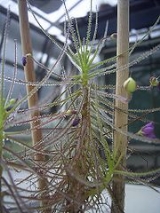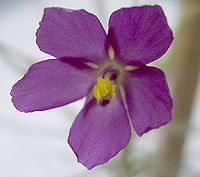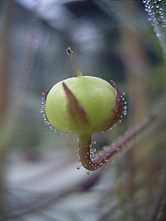
Byblis aquatica
Encyclopedia
Byblis aquatica is an insectivorous plant
belonging to the genus Byblis
, commonly known as the rainbow plants. It was described by Allen Lowrie
and John Godfrey Conran in 1998, assigned to a group of annual
north Australia
n species known as the "Byblis liniflora
complex". It grows in semi-aquatic conditions and uses stalked mucilagenous glands (similar to those employed by the unrelated sundew
s and Drosophyllum
) covering its leaf surfaces to attract, catch, and digest insect prey to supplement the poor environmental nutrient supply.
s. The central stem can reach a length of 45 cm. (18 in.), although it is only able to support its own weight during early growth (<5 cm.). After that it leans on neighboring plants for support, eventually toppling and growing horizontally along the ground or water surface, with only the growth tip growing uprightly.
are 2-4 cm. (0.8-1.5 in.) long, highly filiform (elongated and narrow), round in cross-section and tapering at the end. Young leaves are bright green and grow uprightly; as they age, they darken to a maroon (color)
and droop. The leaf surface is covered with stalked mucilaginous
gland
s along its entire length. These serve not only to attract and trap insect prey, but also allow the plant to "hold on" to neighboring structures for support.
 Byblis aqauatica flowers are born singly at the tip of 1.5-3 cm. stems similar in appearance to the leaves. These emerge from the leaf axes in mature plants. The five-petaled flowers deep purple flowers appear between January and May (during the Australian summer), although only a few at a time.
Byblis aqauatica flowers are born singly at the tip of 1.5-3 cm. stems similar in appearance to the leaves. These emerge from the leaf axes in mature plants. The five-petaled flowers deep purple flowers appear between January and May (during the Australian summer), although only a few at a time.
 The generally glabrous, ovate sepal
The generally glabrous, ovate sepal
s are 3-4 mm. long. The obovate petals are deep purple, 5-7 mm. long and up to 4.5 mm. wide, and have notched margins. The filament
s are 2-2.5 mm. long, bearing 0.9-1.3 mm. anthers. The pistils are 2-2.5 mm. long and bear a rough stigma.
Fertilized flowers mature to form a 3-4 mm by 2.5-4 mm egg shaped, two-parted seed capsules. As the seed capsule dries out it cracks open (dehisces), dropping the seed on the ground or water surface (see the gravity and water dispersal
). The black, 1-1.3 mm. long seeds are grooved lengthwise.
. It is endemic to the area between Darwin
and Berry Springs, but is fairly common there. It grows in the loamy sand of seasonally flooded depressions and in the shallow margins of freshwater lagoon
s. Here it shares its habitat with B. liniflora
. which is however native to dryer regions elsewhere.
in April 1988. In cultivation it was taken for an ecotype of B. liniflora and assigned the name Byblis aff. liniflora "Darwin". It remained thus until Barry Meyers-Rice demonstrated evidence of the reproductive isolation of the species, at which Jan Flisek suggested the description of the taxa as a new species in 1996. Allen Lowrie did so as part of his revision of north Australian species in 1998.
Carnivorous plant
Carnivorous plants are plants that derive some or most of their nutrients from trapping and consuming animals or protozoans, typically insects and other arthropods. Carnivorous plants appear adapted to grow in places where the soil is thin or poor in nutrients, especially nitrogen, such as acidic...
belonging to the genus Byblis
Byblis (plant)
Byblis is a small genus of carnivorous plants, sometimes termed the rainbow plants for the attractive appearance of their mucilage-covered leaves in bright sunshine. Native to western Australia, it is the only genus in the family Byblidaceae. The first species in the genus was described by the...
, commonly known as the rainbow plants. It was described by Allen Lowrie
Allen Lowrie
Allen Lowrie is a West Australian botanist. He is living in Duncraig, a Perth suburb, is married and has two daughters.Lowrie, originally a businessman and inventor, got in contact with the carnivorous flora of western Australia in the late sixties and worked on it as an amateur...
and John Godfrey Conran in 1998, assigned to a group of annual
Annual plant
An annual plant is a plant that usually germinates, flowers, and dies in a year or season. True annuals will only live longer than a year if they are prevented from setting seed...
north Australia
Australia
Australia , officially the Commonwealth of Australia, is a country in the Southern Hemisphere comprising the mainland of the Australian continent, the island of Tasmania, and numerous smaller islands in the Indian and Pacific Oceans. It is the world's sixth-largest country by total area...
n species known as the "Byblis liniflora
Byblis liniflora
Byblis liniflora is a species of carnivorous plant in the Byblidaceae family. It is found in Australia, Indonesia, and Papua New Guinea.-References:* Conran, J.G., Lowrie, A. & Leach, G. 2000. . Downloaded on 20 August 2007....
complex". It grows in semi-aquatic conditions and uses stalked mucilagenous glands (similar to those employed by the unrelated sundew
Sundew
Drosera, commonly known as the sundews, comprise one of the largest genera of carnivorous plants, with at least 194 species. These members of the family Droseraceae lure, capture, and digest insects using stalked mucilaginous glands covering their leaf surface. The insects are used to supplement...
s and Drosophyllum
Drosophyllum
Drosophyllum is a genus of carnivorous plants containing the single species Drosophyllum lusitanicum...
) covering its leaf surfaces to attract, catch, and digest insect prey to supplement the poor environmental nutrient supply.
Habit
Byblis aquatica is an annual plant with a usually unbranching central stem supported by fine, fibrous rootRoot
In vascular plants, the root is the organ of a plant that typically lies below the surface of the soil. This is not always the case, however, since a root can also be aerial or aerating . Furthermore, a stem normally occurring below ground is not exceptional either...
s. The central stem can reach a length of 45 cm. (18 in.), although it is only able to support its own weight during early growth (<5 cm.). After that it leans on neighboring plants for support, eventually toppling and growing horizontally along the ground or water surface, with only the growth tip growing uprightly.
Leaves
The plant's leavesLeaf
A leaf is an organ of a vascular plant, as defined in botanical terms, and in particular in plant morphology. Foliage is a mass noun that refers to leaves as a feature of plants....
are 2-4 cm. (0.8-1.5 in.) long, highly filiform (elongated and narrow), round in cross-section and tapering at the end. Young leaves are bright green and grow uprightly; as they age, they darken to a maroon (color)
Maroon (color)
Maroon is a dark red color.-Etymology:Maroon is derived from French marron .The first recorded use of maroon as a color name in English was in 1789.-Maroon :...
and droop. The leaf surface is covered with stalked mucilaginous
Mucilage
Mucilage is a thick, gluey substance produced by most plants and some microorganisms. It is a polar glycoprotein and an exopolysaccharide.It occurs in various parts of nearly all classes of plant, usually in relatively small percentages, and is frequently associated with other substances, such as...
gland
Gland
A gland is an organ in an animal's body that synthesizes a substance for release of substances such as hormones or breast milk, often into the bloodstream or into cavities inside the body or its outer surface .- Types :...
s along its entire length. These serve not only to attract and trap insect prey, but also allow the plant to "hold on" to neighboring structures for support.
Flowers and fruit


Sepal
A sepal is a part of the flower of angiosperms . Collectively the sepals form the calyx, which is the outermost whorl of parts that form a flower. Usually green, sepals have the typical function of protecting the petals when the flower is in bud...
s are 3-4 mm. long. The obovate petals are deep purple, 5-7 mm. long and up to 4.5 mm. wide, and have notched margins. The filament
Stamen
The stamen is the pollen producing reproductive organ of a flower...
s are 2-2.5 mm. long, bearing 0.9-1.3 mm. anthers. The pistils are 2-2.5 mm. long and bear a rough stigma.
Fertilized flowers mature to form a 3-4 mm by 2.5-4 mm egg shaped, two-parted seed capsules. As the seed capsule dries out it cracks open (dehisces), dropping the seed on the ground or water surface (see the gravity and water dispersal
Biological dispersal
Biological dispersal refers to species movement away from an existing population or away from the parent organism. Through simply moving from one habitat patch to another, the dispersal of an individual has consequences not only for individual fitness, but also for population dynamics, population...
). The black, 1-1.3 mm. long seeds are grooved lengthwise.
Distribution
This species has a very limited distribution in the Australian Northern TerritoryNorthern Territory
The Northern Territory is a federal territory of Australia, occupying much of the centre of the mainland continent, as well as the central northern regions...
. It is endemic to the area between Darwin
Darwin, Northern Territory
Darwin is the capital city of the Northern Territory, Australia. Situated on the Timor Sea, Darwin has a population of 127,500, making it by far the largest and most populated city in the sparsely populated Northern Territory, but the least populous of all Australia's capital cities...
and Berry Springs, but is fairly common there. It grows in the loamy sand of seasonally flooded depressions and in the shallow margins of freshwater lagoon
Lagoon
A lagoon is a body of shallow sea water or brackish water separated from the sea by some form of barrier. The EU's habitat directive defines lagoons as "expanses of shallow coastal salt water, of varying salinity or water volume, wholly or partially separated from the sea by sand banks or shingle,...
s. Here it shares its habitat with B. liniflora
Byblis liniflora
Byblis liniflora is a species of carnivorous plant in the Byblidaceae family. It is found in Australia, Indonesia, and Papua New Guinea.-References:* Conran, J.G., Lowrie, A. & Leach, G. 2000. . Downloaded on 20 August 2007....
. which is however native to dryer regions elsewhere.
Botanical history
Byblis aquatica was first collected by Allen LowrieAllen Lowrie
Allen Lowrie is a West Australian botanist. He is living in Duncraig, a Perth suburb, is married and has two daughters.Lowrie, originally a businessman and inventor, got in contact with the carnivorous flora of western Australia in the late sixties and worked on it as an amateur...
in April 1988. In cultivation it was taken for an ecotype of B. liniflora and assigned the name Byblis aff. liniflora "Darwin". It remained thus until Barry Meyers-Rice demonstrated evidence of the reproductive isolation of the species, at which Jan Flisek suggested the description of the taxa as a new species in 1996. Allen Lowrie did so as part of his revision of north Australian species in 1998.
Further reading
- Meyers-Rice, Barry. Byblis - Notes On Forms New To Cultivation. In: Carnivorous Plant NewsletterCarnivorous Plant NewsletterThe Carnivorous Plant Newsletter is the official publication of the International Carnivorous Plant Society , the largest such organization in the world.-History and editorship:...
22: 39-40. - Flísek, Jan. Byblis aff. liniflora "Darwin" - Novy druh rodu Byblis? In: Trifid, Darwiniana 4: 27-28, 43.

